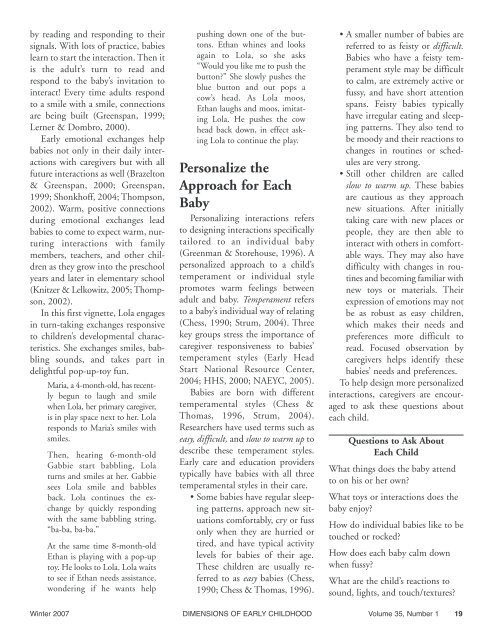Dimensions of Early Childhood - Southern Early Childhood ...
Dimensions of Early Childhood - Southern Early Childhood ...
Dimensions of Early Childhood - Southern Early Childhood ...
Create successful ePaper yourself
Turn your PDF publications into a flip-book with our unique Google optimized e-Paper software.
y reading and responding to their<br />
signals. With lots <strong>of</strong> practice, babies<br />
learn to start the interaction. Then it<br />
is the adult’s turn to read and<br />
respond to the baby’s invitation to<br />
interact! Every time adults respond<br />
to a smile with a smile, connections<br />
are being built (Greenspan, 1999;<br />
Lerner & Dombro, 2000).<br />
<strong>Early</strong> emotional exchanges help<br />
babies not only in their daily interactions<br />
with caregivers but with all<br />
future interactions as well (Brazelton<br />
& Greenspan, 2000; Greenspan,<br />
1999; Shonkh<strong>of</strong>f, 2004; Thompson,<br />
2002). Warm, positive connections<br />
during emotional exchanges lead<br />
babies to come to expect warm, nurturing<br />
interactions with family<br />
members, teachers, and other children<br />
as they grow into the preschool<br />
years and later in elementary school<br />
(Knitzer & Lelkowitz, 2005; Thomp -<br />
son, 2002).<br />
In this first vignette, Lola engages<br />
in turn-taking exchanges responsive<br />
to children’s developmental characteristics.<br />
She exchanges smiles, babbling<br />
sounds, and takes part in<br />
delightful pop-up-toy fun.<br />
Maria, a 4-month-old, has recently<br />
begun to laugh and smile<br />
when Lola, her primary caregiver,<br />
is in play space next to her. Lola<br />
responds to Maria’s smiles with<br />
smiles.<br />
Then, hearing 6-month-old<br />
Gabbie start babbling, Lola<br />
turns and smiles at her. Gabbie<br />
sees Lola smile and babbles<br />
back. Lola continues the ex -<br />
change by quickly responding<br />
with the same babbling string,<br />
“ba-ba, ba-ba.”<br />
At the same time 8-month-old<br />
Ethan is playing with a pop-up<br />
toy. He looks to Lola. Lola waits<br />
to see if Ethan needs assistance,<br />
wondering if he wants help<br />
pushing down one <strong>of</strong> the buttons.<br />
Ethan whines and looks<br />
again to Lola, so she asks<br />
“Would you like me to push the<br />
button?” She slowly pushes the<br />
blue button and out pops a<br />
cow’s head. As Lola moos,<br />
Ethan laughs and moos, imitating<br />
Lola. He pushes the cow<br />
head back down, in effect asking<br />
Lola to continue the play.<br />
Personalize the<br />
Approach for Each<br />
Baby<br />
Personalizing interactions refers<br />
to designing interactions specifically<br />
tailored to an individual baby<br />
(Greenman & Storehouse, 1996). A<br />
personalized approach to a child’s<br />
temperament or individual style<br />
promotes warm feelings between<br />
adult and baby. Temperament refers<br />
to a baby’s individual way <strong>of</strong> relating<br />
(Chess, 1990; Strum, 2004). Three<br />
key groups stress the importance <strong>of</strong><br />
caregiver responsiveness to babies’<br />
temperament styles (<strong>Early</strong> Head<br />
Start National Resource Center,<br />
2004; HHS, 2000; NAEYC, 2005).<br />
Babies are born with different<br />
temperamental styles (Chess &<br />
Thomas, 1996, Strum, 2004).<br />
Researchers have used terms such as<br />
easy, difficult, and slow to warm up to<br />
describe these temperament styles.<br />
<strong>Early</strong> care and education providers<br />
typically have babies with all three<br />
temperamental styles in their care.<br />
• Some babies have regular sleeping<br />
patterns, approach new situations<br />
comfortably, cry or fuss<br />
only when they are hurried or<br />
tired, and have typical activity<br />
levels for babies <strong>of</strong> their age.<br />
These children are usually re -<br />
ferred to as easy babies (Chess,<br />
1990; Chess & Thomas, 1996).<br />
• A smaller number <strong>of</strong> babies are<br />
referred to as feisty or difficult.<br />
Babies who have a feisty temperament<br />
style may be difficult<br />
to calm, are extremely active or<br />
fussy, and have short attention<br />
spans. Feisty babies typically<br />
have irregular eating and sleeping<br />
patterns. They also tend to<br />
be moody and their reactions to<br />
changes in routines or schedules<br />
are very strong.<br />
• Still other children are called<br />
slow to warm up. These babies<br />
are cautious as they approach<br />
new situations. After initially<br />
taking care with new places or<br />
people, they are then able to<br />
interact with others in comfortable<br />
ways. They may also have<br />
difficulty with changes in routines<br />
and becoming familiar with<br />
new toys or materials. Their<br />
expression <strong>of</strong> emotions may not<br />
be as robust as easy children,<br />
which makes their needs and<br />
preferences more difficult to<br />
read. Focused observation by<br />
caregivers helps identify these<br />
babies’ needs and preferences.<br />
To help design more personalized<br />
interactions, caregivers are encouraged<br />
to ask these questions about<br />
each child.<br />
Questions to Ask About<br />
Each Child<br />
What things does the baby attend<br />
to on his or her own?<br />
What toys or interactions does the<br />
baby enjoy?<br />
How do individual babies like to be<br />
touched or rocked?<br />
How does each baby calm down<br />
when fussy?<br />
What are the child’s reactions to<br />
sound, lights, and touch/textures?<br />
Winter 2007 DIMENSIONS OF EARLY CHILDHOOD Volume 35, Number 1 19

















